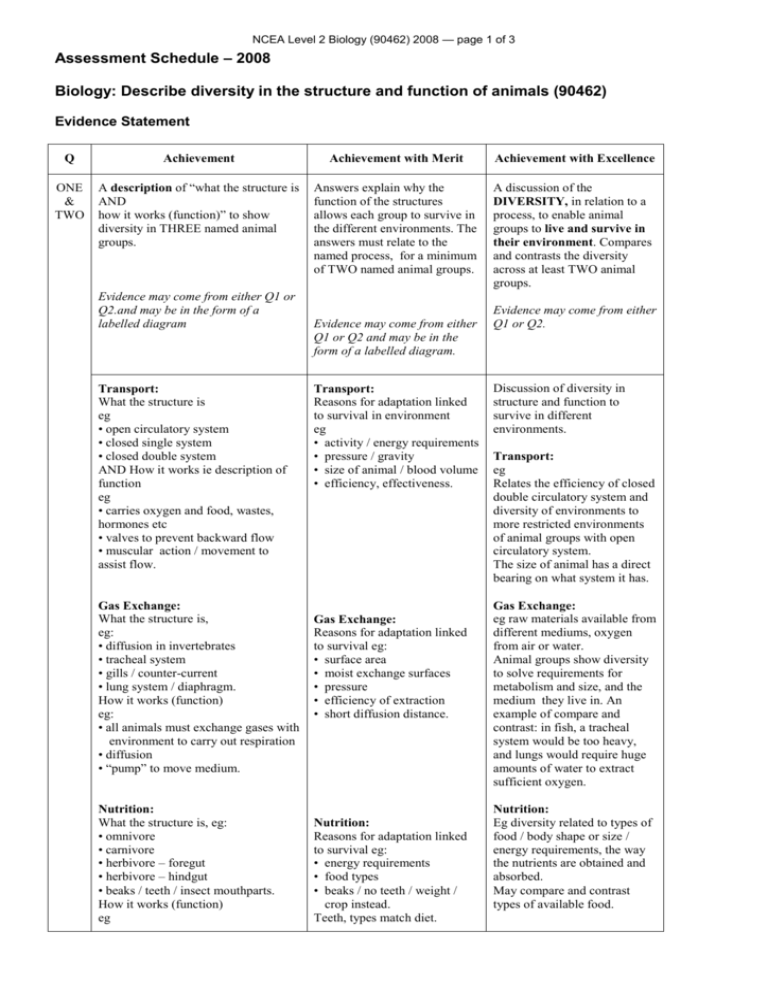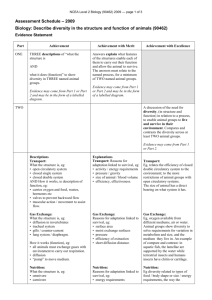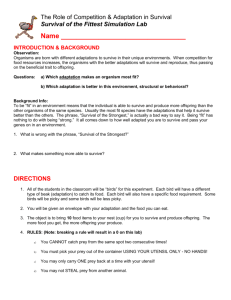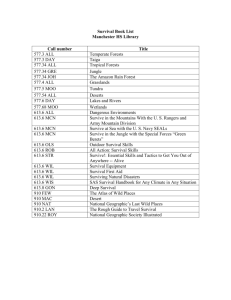54KB - NZQA
advertisement

NCEA Level 2 Biology (90462) 2008 — page 1 of 3 Assessment Schedule – 2008 Biology: Describe diversity in the structure and function of animals (90462) Evidence Statement Q Achievement Achievement with Merit Achievement with Excellence ONE & TWO A description of “what the structure is AND how it works (function)” to show diversity in THREE named animal groups. Answers explain why the function of the structures allows each group to survive in the different environments. The answers must relate to the named process, for a minimum of TWO named animal groups. A discussion of the DIVERSITY, in relation to a process, to enable animal groups to live and survive in their environment. Compares and contrasts the diversity across at least TWO animal groups. Evidence may come from either Q1 or Q2.and may be in the form of a labelled diagram Transport: What the structure is eg • open circulatory system • closed single system • closed double system AND How it works ie description of function eg • carries oxygen and food, wastes, hormones etc • valves to prevent backward flow • muscular action / movement to assist flow. Gas Exchange: What the structure is, eg: • diffusion in invertebrates • tracheal system • gills / counter-current • lung system / diaphragm. How it works (function) eg: • all animals must exchange gases with environment to carry out respiration • diffusion • “pump” to move medium. Nutrition: What the structure is, eg: • omnivore • carnivore • herbivore – foregut • herbivore – hindgut • beaks / teeth / insect mouthparts. How it works (function) eg Evidence may come from either Q1 or Q2 and may be in the form of a labelled diagram. Transport: Reasons for adaptation linked to survival in environment eg • activity / energy requirements • pressure / gravity • size of animal / blood volume • efficiency, effectiveness. Gas Exchange: Reasons for adaptation linked to survival eg: • surface area • moist exchange surfaces • pressure • efficiency of extraction • short diffusion distance. Nutrition: Reasons for adaptation linked to survival eg: • energy requirements • food types • beaks / no teeth / weight / crop instead. Teeth, types match diet. Evidence may come from either Q1 or Q2. Discussion of diversity in structure and function to survive in different environments. Transport: eg Relates the efficiency of closed double circulatory system and diversity of environments to more restricted environments of animal groups with open circulatory system. The size of animal has a direct bearing on what system it has. Gas Exchange: eg raw materials available from different mediums, oxygen from air or water. Animal groups show diversity to solve requirements for metabolism and size, and the medium they live in. An example of compare and contrast: in fish, a tracheal system would be too heavy, and lungs would require huge amounts of water to extract sufficient oxygen. Nutrition: Eg diversity related to types of food / body shape or size / energy requirements, the way the nutrients are obtained and absorbed. May compare and contrast types of available food. NCEA Level 2 Biology (90462) 2008 — page 2 of 3 Animals are consumers and must extract and absorb nutrients • physical / chemical digestion • purpose of dentition types • ruminants – micro-organisms • absorption. Excretion: What the structure is, eg: • an invertebrate system • an aquatic system • a terrestrial system • products. Function, Eg: Osmoregulation, removal of toxic Nitrogen-containing compounds. Support and movement: What the structure is, eg • hydrostatic system • exoskeleton • endoskeleton • flight • swimming. Function, eg: Locomotion – to escape predators, find food, find mates. Antagonistic pairs, muscle types, contraction / relaxation of muscles, flexible body movements. Sensitivity and co-ordination: What the structure is, eg: Receptors / sensing organs for stimuli Motor neurones / sensitivity neurones Response to stimuli • correlation to body symmetry, eg echinoderm, insect, squid • vertebrate central NS. Function (how it works), eg Control and coordination of internal processes, sensing and responding to stimuli. Nervous, endocrine system. Reproduction: What the structure is, eg: • asexual – parthenogenesis • sexual – fertilisation (internal and external) • complex reproductive systems, eg insects. Function, eg: Extinction if death occurs before replacement. Gamete formation, zygote, mitosis, meiosis. Excretion: Reasons for adaptation linked to survival in environment eg: • excretory products • energy efficiency. Excretion: Eg diversity shown is related to the excretion product / energy cost of production in the particular environment, and the challenges it presents. Support and movement: Reasons for adaptation linked to survival eg: • skeleton type adapted for environment • limitations of different media. Support and movement: eg diversity of structure and function related to living in the environment eg endoskeletons; bones, wings adapted for flight, limitation of size for terrestrial animals with exoskeletons. Sensitivity and co-ordination: Reasons for adaptation linked to survival eg: • vertebrate NS highly centralised allowing animals to grow larger • invertebrate NS related to pattern of body symmetry. Reproduction: Reasons for adaptation linked to survival, eg: • external / internal fertilisation • external / internal development (egg laying vs live young.) Sensitivity and co-ordination: eg diversity related to survival in environment and interaction with endocrine system to maintain homeostasis. Reproduction: Eg: diversity related to number of offspring produced and survival in environment. eg of compare and contrast • level of parental care related to the number of offspring. • asexual vs sexual reproduction. NCEA Level 2 Biology (90462) 2008 — page 3 of 3 Judgement Statement – 2008 Achievement Description of structure AND function of THREE named animal groups. Achievement with Merit Explains how adaptations in structure and function allow survival. Achievement plus TWO out of three animal groups explained sufficiently. Achievement with Excellence Discussion links the need for diversity to survive in a range of environments. (Must compare and contrast between at least TWO animal groups.) As for Merit plus E.










